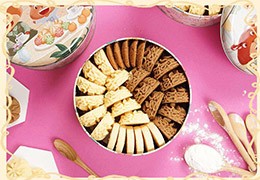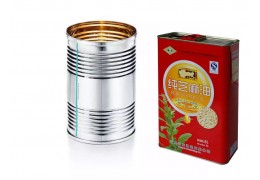Keksdosen sind mehr...
Cigarette tin box
Cigarette tin boxes are made of tin-plated iron as raw materials, which are made of tin-plated iron through different processes such as welding or stamping and buckle bones.

1. Classification of cigarette tin boxes--Sort by shape
1) Round cigarette tin cans, tin cans are divided into two structures
①Straight-body tank; the top and bottom diameters of the tank body remain unchanged. Commonly used round cigarette cans 67*96mm
②Necked cans; tin cans with reduced diameters at the top and/or bottom of the can body are used to hold cigarettes. Commonly used sizes are 50*104mm
2) Rectangular cigarette tin box; the commonly used specifications of three rectangular cigarette tin boxes are: 99*29mm, etc., the height can be adjusted according to customer requirements, and the top cover generally adopts a hinged cover. Common products are marijuana cigarette boxes, cigar boxes and the like.
3) Square cigarette tin box-the main dimensions are: 96*96*12mm; 66*66*14mm and so on. The structural body of the square cigarette tin box is generally made of buckle bones or stretched, and has a good airtightness.
From the structure, it can be divided into: welded tank, buckle tank, stretch tank, two-piece tank, three-piece tank, etc.
2. The structure of cigarette tin box
Round cigarette tin cans, rectangular cigarette tin boxes, and square cigarette tin boxes all belong to the buckle structure. The national policy has formulated relevant product standards for tin boxes. The principle used is that the materials to be spliced are spliced by a pair of rotating upper and lower hooks with a certain amount of overlap to complete the splicing. Because of the structure and size of this kind of cigarette tin can, each customer can adjust it according to their own products. Therefore, and There is no relevant national standard.

3. Introduction of raw materials
The raw material used in cigarette tin boxes is tin-plated iron, which originated in Bohemia (in today's Czech Republic and Slovakia). The area has been rich in metal since ancient times, with advanced technology, and knows how to use hydraulic power to engage in machine manufacturing. Tin-plated iron has been produced since the 14th century. After the First World War, the armies of various countries made a large number of iron containers (cans) and continue to use them today. It is an iron sheet coated with a layer of tin on the surface, which is not easy to rust. In order to reduce production costs, not all cigarette metal boxes are tin-plated on the surface, and thin plates without tin-plating are called substrates. Some substrates are galvanized or chrome-plated, unlike tin-plated iron, which is a thin steel plate that is not tin-plated. Since tin is a precious metal, the prices of chromium and zinc are both cheaper than tin. If the surface is not plated with tin foil, the most obvious thing is that the production cost is reduced.
According to the different requirements of the cigarette packaging industry, the thickness of the packaging material, the amount of tin plating, and the mechanical properties have different needs.
4. Characteristics of cigarette tin box
①Impermeability
Light will trigger the deterioration reaction of cigarettes, and the opacity is good for better preservation of cigarettes, and will not cause cigarettes to produce oxidative peculiar smell.
②Good airtightness
The barrier properties of cigarette packaging containers to air and other volatile gases are very important for the preservation of cigarette quality. Comparison of cigarette packaging containers of various materials proves that the oxygen transmission rate of the container directly affects the preservation of cigarettes; tin boxes with low oxygen transmission rate are better stored.

5. Printing process of cigarette tin box
1. Printing ink
Ink plays a decisive role in tin box, it can be said that without ink, it is difficult to have tin box printing. Tin box printing is not the ultimate goal, but a means of beautifying the tin box packaging. The purpose is to make a variety of exquisite cigarette containers. To make the graphics printed on the cigarette tin box bright and eye-catching, the special effect of ink is inseparable . Ink is a kind of chemical product made of resin and oil that contains or does not contain pigment. It is coated on the surface of packaging materials or containers and can be dried to form a continuous, uniform and strong thin protective film.
2. Printing principle
(1) The ink is required to have good adhesion and mechanical properties
Since the tin-plated iron printed matter is finally made into a cigarette container, it needs to be cut, bent and stretched. Therefore, the printing ink is required to have good adhesion to the tin-plated iron and corresponding mechanical properties. In order to improve the ink adhesion, the tin-plated iron needs to be white painted before printing. White is the base color of all pictures, with high brightness. After adding other high-energy hues, the brightness of each hue can be increased to form a color gradation.
(2) Requirements for white ink
The surface of tin-plated iron is silvery white (or yellow) with metallic luster. Before printing color graphics, the surface needs to be painted or printed white. Due to the limitation of ink coverage, monochromatic machines often need to print white twice. The whiteness can reach 75%. Whiteness is an important indicator of the quality of tinplate printing products. The white ink is required to have a good bonding force with the primer, and it will not yellow after repeated high-temperature baking, and will not fade after high-temperature steaming. Prime the tinplate to increase the adhesion to the tinplate and have a good adhesion to the white ink. Commonly used primers are epoxy amine-based, with light color, no yellowing, no aging after repeated baking, and good flexibility and impact resistance.
(3) Requirements for color ink
In addition to a certain degree of water resistance, the colored inks printed on tin-plated iron also need special requirements. Since the surface of tin-plated iron is impermeable to moisture and solvents and needs to be baked and dried, the ink should be heat-curable. High requirements for pigments' tinting strength and durability. In addition to the basic properties of general offset printing inks, iron printing inks should also have heat resistance, strong ink film adhesion, impact resistance, good hardness, cooking resistance and light resistance according to the characteristics of iron printing.

6. Production standards for cigarette tin boxes
Main parts: reflect the main body's pattern, text, mark and bar code position.
Slight scratches: no more than 0.3mm*20mm on the printed surface, no traces of iron scratches.
Main viewing surface: The external surface that can be observed by placing the front of the product graphic and text directly in front of and directly under the sunlight.
Non-frontal view: Surfaces other than the frontal view, such as the back, side, bottom, and inner surfaces.


















Latest comments